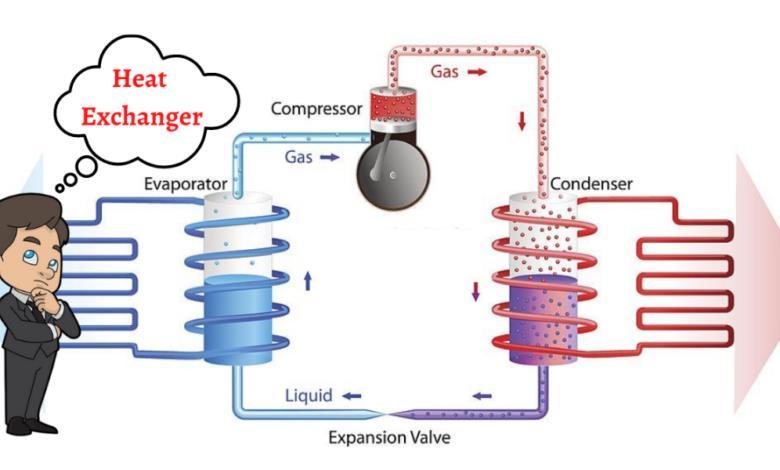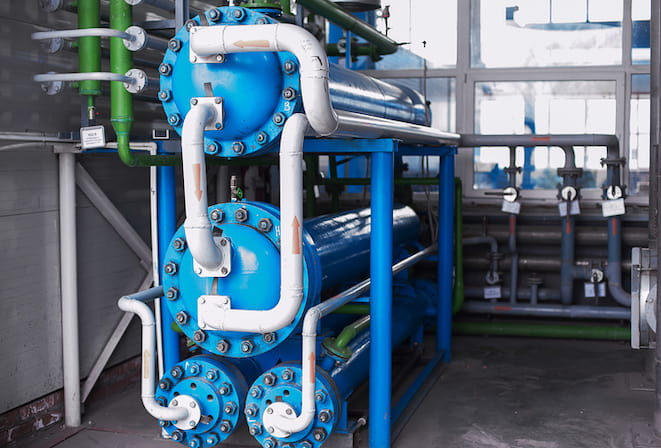How DVS Heat Transfer Systems Apply Advanced Materials to Boost Thermal Conductivity
Wiki Article
Innovations in Heat Transfer Solutions: What You Need to Know for Optimal Efficiency
Innovations in Heat transfer systems are transforming performance throughout various sectors. Advanced products like graphene and nanofluids assure considerable enhancements in thermal conductivity. Meanwhile, the assimilation of IoT and equipment discovering provides opportunities for real-time tracking and improved energy performance. Nonetheless, the landscape of thermal administration is rapidly advancing (DVS Heat Transfer Systems). Understanding these growths is vital for attaining suitable system performance and sustainability in the future. What certain advancements are forming this change?Arising Materials for Enhanced Heat Transfer

Advanced Heat Exchanger Designs
While traditional Heat exchangers have actually offered their objective in various applications, advanced designs are now arising to fulfill the enhancing demands for effectiveness and performance. These cutting-edge designs, such as plate, shell-and-tube, and finned-tube Heat exchangers, integrate boosted area and boosted circulation patterns to enhance thermal transfer prices. In addition, small styles allow for decreased room requirements without jeopardizing effectiveness. Advanced materials, such as composites and corrosion-resistant alloys, in addition improve durability and efficiency under severe conditions. Furthermore, simulation modern technologies and computational fluid characteristics are increasingly utilized to improve these layouts, guaranteeing peak Heat transfer qualities. As industries seek to decrease power consumption and take full advantage of outcome, the fostering of sophisticated Heat exchanger styles is pivotal in achieving these objectives.The Duty of Nanotechnology in Heat Transfer
Nanotechnology plays an essential function in boosting thermal conductivity within Heat transfer systems. By manipulating materials at the nanoscale, researchers have actually attained considerable improvements in energy performance. These innovations not just enhance efficiency yet likewise contribute to more lasting energy services.Boosted Thermal Conductivity
Substantial advancements in thermal conductivity have actually arised with the application of nanotechnology, revolutionizing Heat transfer systems across different markets. By including nanoparticles into Heat transfer liquids and materials, researchers have attained remarkable increases in thermal conductivity. These nanoparticles, such as carbon nanotubes, graphene, and metal oxides, improve the Heat transfer residential properties because of their high area and distinct thermal features. The resulting compounds exhibit improved efficiency in applications varying from electronic devices cooling systems to renewable resource technologies. The capacity to tailor the size, shape, and make-up of nanoparticles permits for optimized thermal monitoring solutions. As an outcome, nanotechnology remains to play a crucial function in the growth of a lot more effective and effective Heat transfer systems, leading the way for enhanced industrial applications.
Power Performance Improvements

Integration of IoT in Heat Transfer Solutions
The combination of IoT in Heat transfer systems presents the application of smart sensors that boost functional effectiveness. These sensors enable real-time information monitoring, enabling prompt modifications and optimizations. This technical innovation has the potential to substantially enhance performance and power administration in Heat transfer applications.Smart Sensors Execution
As Heat transfer systems progress, the assimilation of smart sensors through the Internet of Things (IoT) has become a transformative approach. These sensing units enable real-time monitoring of circulation, temperature level, and stress prices, improving system effectiveness and integrity. By collecting and transmitting information, they assist in positive upkeep, minimizing the threat of system failings. Furthermore, wise sensing units add to power financial savings by refining operational specifications based upon ecological problems. Their capacity to examine trends and anomalies permits informed decision-making, guaranteeing peak efficiency of Heat transfer systems. As industries increasingly adopt this technology, the execution of clever sensing units stands to revolutionize how Heat transfer systems DVS Heat Transfer Systems are handled, leading the way for greater sustainability and boosted efficiency results.Real-Time Data Monitoring
Just how can real-time data keeping an eye on improve the efficiency of Heat transfer systems? By integrating Net of Points (IoT) technology, Heat transfer systems can leverage constant information collection from smart sensing units. This real-time monitoring enables instant analysis of flow, temperature level, and pressure prices, allowing drivers to determine inefficiencies without delay. As a result, adjustments can be made to enhance performance, decrease power consumption, and prolong devices life-span. Furthermore, anticipating maintenance can be carried out, reducing unanticipated downtime and pricey repair work. The capability to visualize performance metrics with control panels improves decision-making, fostering a positive technique to system monitoring. Ultimately, real-time data monitoring not only improves operational effectiveness yet also adds to sustainability goals within industrial procedures.Power Efficiency and Sustainability Trends
Energy efficiency and sustainability fads are improving the landscape of Heat transfer systems, driving innovation and compliance across different markets. Organizations are significantly focusing on energy-efficient layouts to reduce operational costs and minimize environmental influences. The assimilation of sustainable energy sources is ending up being more common, allowing Heat transfer systems to operate sustainably while satisfying regulative requirements. Additionally, improvements in products and modern technologies advertise lower energy intake and enhance total efficiency. Lifecycle evaluations are likewise acquiring grip, enabling business to assess the ecological effect of Heat transfer systems from production to disposal. This concentrate on sustainability not just sustains corporate duty yet likewise positions organizations competitively in a market where consumers increasingly prefer eco-friendly options. Energy effectiveness and sustainability remain crucial factors to consider for future advancements in Heat transfer modern technology.Advancements in Thermal Management Solutions
While the need for efficient Heat transfer proceeds to rise, technologies in thermal administration options are emerging to resolve both performance and sustainability obstacles. Advanced materials, such as phase adjustment materials and nanofluids, are being created to enhance Heat transfer efficiency - DVS Heat Transfer Systems. These materials boost thermal conductivity and permit far better temperature level policy in numerous applications. Additionally, modern technologies like energetic thermal control systems are gaining grip, enabling real-time adjustments to manage Heat circulation effectively. These systems add to power savings and decrease the ecological impact of thermal processes. The combination of IoT in thermal monitoring facilitates monitoring and anticipating maintenance, guaranteeing enhanced efficiency and durability of Heat transfer systems. Generally, these innovations represent significant strides towards more lasting thermal administration techniquesFuture Instructions in Heat Transfer Modern Technology
Arising advancements in thermal management remedies signal an appealing future for Heat transfer innovation. Researchers are increasingly concentrating on establishing products with remarkable thermal conductivity and enhanced energy effectiveness. Developments such as nanofluids, which include suspended nanoparticles, supply significant renovations in Heat transfer efficiency. In addition, the integration of clever products that adjust to varying temperature level conditions is acquiring grip, enabling even more efficient and receptive systems. The rise of additive manufacturing strategies is additionally allowing the design of complex Heat exchanger geometries that maximize liquid flow. The implementation of equipment knowing algorithms is expected to reinvent the optimization of Heat transfer systems, promoting predictive maintenance and efficiency improvement. Collectively, these advancements are poised to change the landscape of Heat transfer technologies in numerous markets.
Frequently Asked Inquiries

Exactly how Do I Select the Right Heat Transfer System for My Application?
Choosing the ideal Heat transfer system entails assessing application requirements, including temperature arrays, fluid residential properties, and performance requirements. Examining system types, upkeep factors to consider, and cost-effectiveness likewise plays an important role in making an informed choice.What Are the Upkeep Demands for Advanced Heat Exchangers?
Upkeep needs for innovative Heat exchangers generally include routine evaluations, keeping track of for leakages, cleaning of surface areas, and ensuring optimal flow prices. Complying with supplier standards assurances efficient procedure and prolongs the devices's lifespan.
Just How Do Environmental Factors Impact Heat Transfer Effectiveness?
Environmental aspects significantly influence Heat transfer performance. Variations in airflow, temperature, and moisture effect thermal conductivity and convective Heat transfer, eventually impacting system performance and demanding consideration during the style and operation of Heat transfer systems.What Safety Requirements Apply to Heat Transfer Equipments?
Security requirements for Heat transfer systems generally include standards from companies such as ASME and ASTM. DVS Heat Transfer Systems. These criteria address materials, design, and operational methods to ensure dependability, performance, and defense against hazards in various applications
Just How Can I Troubleshoot Usual Heat Transfer System Issues?
Repairing usual Heat transfer system concerns entails looking for leakages, making sure proper fluid flow, examining insulation integrity, and validating temperature differentials. Identifying these factors can help maintain system effectiveness and protect against further complications.Nanotechnology plays a necessary duty in enhancing thermal conductivity within Heat transfer systems. Significant advancements in thermal conductivity have arised through the application of nanotechnology, changing Heat transfer systems across different markets. Improvements in thermal conductivity with nanotechnology have actually led the means for impressive enhancements in energy efficiency within Heat transfer systems. Energy performance and sustainability patterns are reshaping the landscape of Heat transfer systems, driving development and compliance throughout different industries. The assimilation of IoT in thermal monitoring assists in tracking and anticipating upkeep, ensuring optimized efficiency and longevity of Heat transfer systems.
Report this wiki page